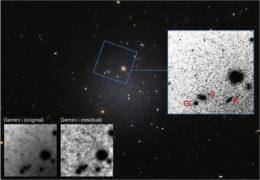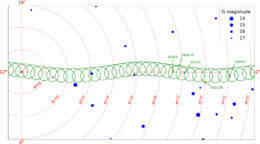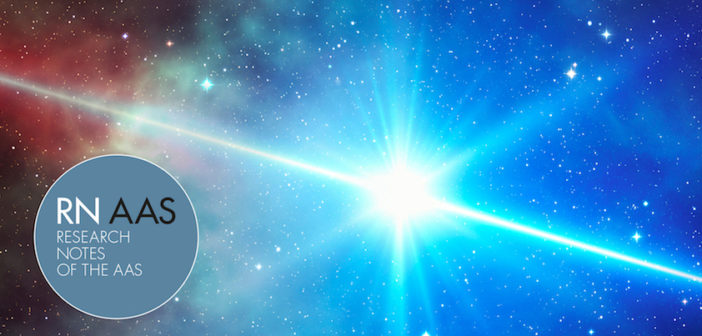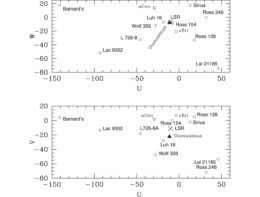Editor’s note: This week, we celebrate one year since we first launched Research Notes of the American Astronomical Society (RNAAS) — a non-peer-reviewed, indexed, and secure record of brief works in astronomy and astrophysics. Editor Chris Lintott shares his thoughts on one year of RNAAS below.
Launched in October 2017, Research Notes of the AAS (RNAAS) has now reached its first birthday. The idea behind RNAAS was to provide a venue for quick and easy publishing of things that otherwise might not enter the formal record, like negative results, one-off observations, or student projects. We knew what the format was — one figure or table, 1,000 words — but the truth is, I don’t think any of us knew quite what to expect.
A year on, it seems evident that RNAAS is an enormous success. 243 notes have been accepted, and the diversity has been astounding. There have been flurries of activity around exciting events, like the passage of ‘Oumuamua through our solar system or the release of Gaia data, but there have also been conference reports, theoretical notes, comments on statistical techniques, reports of observations by students, (polite) quibbles with published results, suggestions for classroom activities, and even people using Research Notes to record predictions. I’m also excited to see people using RNAAS to publicise the release of catalogues and data online, rather than allowing the need for a full paper be a reason to delay or not to document such a release.
We’ve highlighted just a few of my favourites below, but it’s the variety that strikes me. It turns out that all sorts of people wanted an open, slightly formal (indexed in ADS!), but not peer-reviewed way of recording their thoughts and efforts, and my mornings are enlivened by reading them as part of the moderation process. Another pleasant surprise has been the degree to which RNAAS has entered the mainstream of astronomical work; nearly 70 Notes have already been cited.
My thanks to the Journals team, and to my fellow editors who help keep an eye on things. We’ve all worked to keep to our goals of being fast and keepingNotes both free to publish and free to read without being too rough around the edges. If you have any suggestions, do get in touch.
I hope you’ll keep Research Notes in mind for pretty much anything, and drop me an email if you have questions about what might be suitable. The odds are we’d love to publish your thoughts.
Chris Lintott
Editor, Research Notes of the AAS
Highlights from a Year of RNAAS
Want a taste of the research that’s been published in the first year of RNAAS? Check out these ten suggestions from RNAAS Editor Chris Lintott.
“Kinematics of the Interstellar Vagabond 1I/‘Oumuamua (A/2017 U1),” Eric Mamajek 2017 Res. Notes AAS 1 21. doi:10.3847/2515-5172/aa9bdc
Calculations in this Note support a picture in which the asteroid 1I/’Oumuamua (A/2017 U1) originated from outside of our solar system, but did not come from any of the dozen star systems nearest to us. This is currently the most-cited Research Note and has been downloaded more than 1,300 times.
“The Third Workshop on Extremely Precise Radial Velocities: The New Instruments,” Jason T. Wright and Paul Robertson 2017 Res. Notes AAS 1 51. doi:10.3847/2515-5172/aaa12e
This Note provides a very brief overview of events during the Third Workshop on Extremely Precise Radial Velocities, held in Pennsylvania in August 2016. The Note includes a link to a table produced during the workshop that summarizes nearly all of the next-generation extremely precise Doppler velocimeters being designed, built, or commissioned today.
“Strong Hydrogen Absorption at Cosmic Dawn: The Signature of a Baryonic Universe,” Stacy S. McGaugh 2018 Res. Notes AAS 2 37. doi:10.3847/2515-5172/aab497
After the groundbreaking discovery of the signature of light from the very first stars in the universe, first announced in February 2018, this Note rapidly followed on its heels with a theoretical explanation for the signal’s unexpected strength.
“Another unWISE Update: The Deepest Ever Full-sky Maps at 3-5 μm,” A. M. Meisner et al 2018 Res. Notes AAS 2 1. doi:10.3847/2515-5172/aaa4bc
This Note presents the deepest ever fully-sky maps at 3.4 and 4.6 µm, built by reprocessing ~140 terabytes of infared images from the Wide-field Infrared Survey Explorer (WISE) and Near-Earth Object Wide-field Survey Explorer (NEOWISE) missions.

The backwards “S” shape faintly visible in the true-color image of NGC1052-DF2 (background) and zoomed insets may be a cold stellar stream. [Abraham et al. 2018]
Remember the controversial NGC1052-DF2, the ultra-diffuse galaxy reported to be strangely lacking dark matter? This Note reports on the provisional detection of a cold stellar stream within this galaxy, cautiously referred to as “The Maybe Stream”. If confirmed, this would be located 500 times further away than the current most-distant cold stellar stream known.
“No Bursts Detected from FRB121102 in Two 5 hr Observing Campaigns with the Robert C. Byrd Green Bank Telescope,” Danny C. Price et al 2018 Res. Notes AAS 2 30. doi:10.3847/2515-5172/aaaf69
This Note is an excellent example of a helpfully documented null result. The repeating fast radio burst FRB 121102 was observed over two 5-hour observation sessions on the 100-m Green Bank Telescope, and no bursts were detected during that time. These are among the longest published contiguous observations of FRB 121102, and support the notion that FRB 121102 bursts are episodic.
“The Spectroscopic Classification of Seven Cataclysmic Variables with the Liverpool Telescope,” E. W. Upsdell et al 2018 Res. Notes AAS 2 161. doi:10.3847/2515-5172/aadee7
This Note presents a student project in which the spectra of seven cataclysmic variables — observed using the 2-m Liverpool Telescope in the UK — are analyzed. The objects are shown to be consistent with dwarf novae.
“Predicting The Orbit of TRAPPIST-1i,” David Kipping 2018 Res. Notes AAS 2 136. doi:10.3847/2515-5172/aad6e8
What would the period be for a hypothetical eighth planet in TRAPPIST-1, an exoplanetary system currently known to host seven planets that share near mean motion resonances with their neighbors? This Note presents a prediction that we can hope to test, should we discover TRAPPIST-1i in the future.

Path, in green, of the apparent position of the North Celestial Pole (i.e., the center of star trails) as a function of time. [Wright 2018]
For professors looking for an interesting class project, check out this Note, which describes a student project to measure the aberration of starlight caused by the motion of the Earth. With just a small telescope and camera, students can directly prove that the Earth travels around the Sun.
“Unbiased Inference of the Masses of Transiting Planets from Radial Velocity Follow-up,” Benjamin T. Montet 2018 Res. Notes AAS 2 28. doi:10.3847/2515-5172/aac2c1
This Note reveals an overlooked observational bias toward artificially high mass values estimated for planets discovered via the radial velocity method. The author proposes a means for avoiding this bias in the future.


1 Comment
Pingback: AAS Nova – New